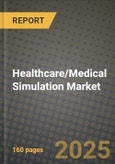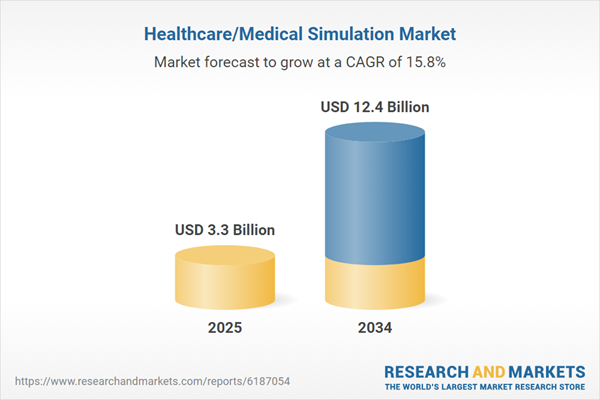The Healthcare/Medical Simulation Market is experiencing rapid growth as simulation-based learning becomes a cornerstone of modern medical education and training. Medical simulation provides a risk-free, controlled environment for healthcare professionals to practice procedures, decision-making, and patient interaction using high-fidelity manikins, virtual reality (VR), task trainers, and standardized patients. It enhances clinical competence, improves patient safety, and reduces medical errors by allowing learners to rehearse complex scenarios before facing real-life patients. The demand for simulation technologies is rising across hospitals, academic institutions, military healthcare settings, and research centers. This market spans products such as anatomical models, software, and training services. With the growing emphasis on experiential learning, interdisciplinary training, and technological integration, the healthcare simulation market is evolving as a critical component of healthcare systems globally.
The Healthcare/Medical Simulation Market witnessed substantial growth due to ongoing efforts to modernize medical education post-pandemic. Institutions prioritized simulation-based learning to compensate for limited clinical exposure during medical training disruptions. VR and AR-based platforms gained prominence for remote and immersive learning experiences. Leading companies introduced AI-enhanced simulation systems capable of replicating real-time physiological responses, allowing more nuanced, dynamic practice scenarios. Hybrid simulation programs combining online modules with in-person training gained traction, offering flexibility and wider reach. Additionally, healthcare organizations used simulation tools for continuous professional development and team-based training to improve interprofessional collaboration and crisis management. Partnerships between tech providers and educational institutions surged, promoting innovation and scalability of simulation programs across regions and specialties.
The Healthcare/Medical Simulation Market is expected to grow even more dynamically, driven by integration with advanced technologies such as artificial intelligence, machine learning, and real-time analytics. Personalized simulation modules tailored to individual skill levels and specialties will become mainstream, enabling adaptive learning paths for students and professionals. The global expansion of telehealth and digital health solutions will further increase the need for virtual simulation tools to prepare healthcare workers for remote patient interaction. Regulatory bodies are anticipated to mandate simulation-based certification for high-risk medical procedures, fueling consistent demand. Emerging economies are projected to invest heavily in simulation centers to bridge skill gaps and enhance clinical training infrastructure. As the healthcare workforce becomes increasingly digital-native, immersive simulation experiences will become central to both education and clinical readiness.
Key Insights: Healthcare/Medical Simulation Market
- Adoption of virtual reality (VR) and augmented reality (AR) in medical simulation is revolutionizing training by offering immersive, interactive learning experiences for students and professionals alike.
- Simulation is being integrated into interdisciplinary team training to enhance collaboration, communication, and response time in emergency and critical care scenarios.
- Cloud-based simulation platforms are gaining popularity, enabling remote access to simulation tools and content, and supporting global collaboration and standardized training.
- There is a growing emphasis on AI-enabled simulations that adapt in real-time to learner responses, providing personalized feedback and performance assessments.
- Hybrid training models combining online theory modules with in-person simulation labs are expanding accessibility and flexibility in medical education and upskilling.
- Growing concerns around patient safety and the need to reduce medical errors are pushing institutions to adopt simulation-based learning and assessment tools.
- Shortages in clinical training opportunities are increasing reliance on simulation to provide consistent and standardized practical experience to students and residents.
- Technological advancements in VR, AR, and haptics are making simulation tools more realistic, engaging, and effective in replicating clinical conditions and procedures.
- Increased government and institutional funding for medical education reform and workforce development is supporting the expansion of simulation centers globally.
- The high cost of acquiring and maintaining advanced simulation equipment and the lack of trained instructors remain major hurdles, particularly for institutions in low-resource settings.
Healthcare/Medical Simulation Market Segmentation
By Product and Service
- Healthcare Anatomical Models
- Web-Based Simulation
- Healthcare Simulation Software
- Simulation Training Services
By End-User
- Academic Institutes
- Hospitals
- Military Organizations
- Other End-Users
By Technology
- High-Fidelity Simulators
- Medium-Fidelity Simulators
- Low-Fidelity Simulators
Key Companies Analysed
- CAE Healthcare
- Laerdal Medical
- 3D Systems, Inc.
- Gaumard Scientific Company, Inc.
- Kyoto Kagaku Co., Ltd.
- Simulab Corporation
- Limbs & Things Ltd.
- Mentice AB
- VirtaMed AG
- Inovus Medical Ltd.
Healthcare/Medical Simulation Market Analytics
The report employs rigorous tools, including Porter’s Five Forces, value chain mapping, and scenario-based modeling, to assess supply-demand dynamics. Cross-sector influences from parent, derived, and substitute markets are evaluated to identify risks and opportunities. Trade and pricing analytics provide an up-to-date view of international flows, including leading exporters, importers, and regional price trends.Macroeconomic indicators, policy frameworks such as carbon pricing and energy security strategies, and evolving consumer behavior are considered in forecasting scenarios. Recent deal flows, partnerships, and technology innovations are incorporated to assess their impact on future market performance.
Healthcare/Medical Simulation Market Competitive Intelligence
The competitive landscape is mapped through proprietary frameworks, profiling leading companies with details on business models, product portfolios, financial performance, and strategic initiatives. Key developments such as mergers & acquisitions, technology collaborations, investment inflows, and regional expansions are analyzed for their competitive impact. The report also identifies emerging players and innovative startups contributing to market disruption.Regional insights highlight the most promising investment destinations, regulatory landscapes, and evolving partnerships across energy and industrial corridors.
Countries Covered
- North America - Healthcare/Medical Simulation market data and outlook to 2034
- United States
- Canada
- Mexico
- Europe - Healthcare/Medical Simulation market data and outlook to 2034
- Germany
- United Kingdom
- France
- Italy
- Spain
- BeNeLux
- Russia
- Sweden
- Asia-Pacific - Healthcare/Medical Simulation market data and outlook to 2034
- China
- Japan
- India
- South Korea
- Australia
- Indonesia
- Malaysia
- Vietnam
- Middle East and Africa - Healthcare/Medical Simulation market data and outlook to 2034
- Saudi Arabia
- South Africa
- Iran
- UAE
- Egypt
- South and Central America - Healthcare/Medical Simulation market data and outlook to 2034
- Brazil
- Argentina
- Chile
- Peru
Research Methodology
This study combines primary inputs from industry experts across the Healthcare/Medical Simulation value chain with secondary data from associations, government publications, trade databases, and company disclosures. Proprietary modeling techniques, including data triangulation, statistical correlation, and scenario planning, are applied to deliver reliable market sizing and forecasting.Key Questions Addressed
- What is the current and forecast market size of the Healthcare/Medical Simulation industry at global, regional, and country levels?
- Which types, applications, and technologies present the highest growth potential?
- How are supply chains adapting to geopolitical and economic shocks?
- What role do policy frameworks, trade flows, and sustainability targets play in shaping demand?
- Who are the leading players, and how are their strategies evolving in the face of global uncertainty?
- Which regional “hotspots” and customer segments will outpace the market, and what go-to-market and partnership models best support entry and expansion?
- Where are the most investable opportunities - across technology roadmaps, sustainability-linked innovation, and M&A - and what is the best segment to invest over the next 3-5 years?
Your Key Takeaways from the Healthcare/Medical Simulation Market Report
- Global Healthcare/Medical Simulation market size and growth projections (CAGR), 2024-2034
- Impact of Russia-Ukraine, Israel-Palestine, and Hamas conflicts on Healthcare/Medical Simulation trade, costs, and supply chains
- Healthcare/Medical Simulation market size, share, and outlook across 5 regions and 27 countries, 2023-2034
- Healthcare/Medical Simulation market size, CAGR, and market share of key products, applications, and end-user verticals, 2023-2034
- Short- and long-term Healthcare/Medical Simulation market trends, drivers, restraints, and opportunities
- Porter’s Five Forces analysis, technological developments, and Healthcare/Medical Simulation supply chain analysis
- Healthcare/Medical Simulation trade analysis, Healthcare/Medical Simulation market price analysis, and Healthcare/Medical Simulation supply/demand dynamics
- Profiles of 5 leading companies - overview, key strategies, financials, and products
- Latest Healthcare/Medical Simulation market news and developments
Additional Support
With the purchase of this report, you will receive:- An updated PDF report and an MS Excel data workbook containing all market tables and figures for easy analysis.
- 7-day post-sale analyst support for clarifications and in-scope supplementary data, ensuring the deliverable aligns precisely with your requirements.
- Complimentary report update to incorporate the latest available data and the impact of recent market developments.
This product will be delivered within 1-3 business days.
Table of Contents
Companies Mentioned
- CAE Healthcare
- Laerdal Medical
- 3D Systems Inc.
- Gaumard Scientific Company Inc.
- Kyoto Kagaku Co. Ltd.
- Simulab Corporation
- Limbs & Things Ltd.
- Mentice AB
- VirtaMed AG
- Inovus Medical Ltd.
Table Information
| Report Attribute | Details |
|---|---|
| No. of Pages | 160 |
| Published | October 2025 |
| Forecast Period | 2025 - 2034 |
| Estimated Market Value ( USD | $ 3.3 Billion |
| Forecasted Market Value ( USD | $ 12.4 Billion |
| Compound Annual Growth Rate | 15.8% |
| Regions Covered | Global |
| No. of Companies Mentioned | 10 |









